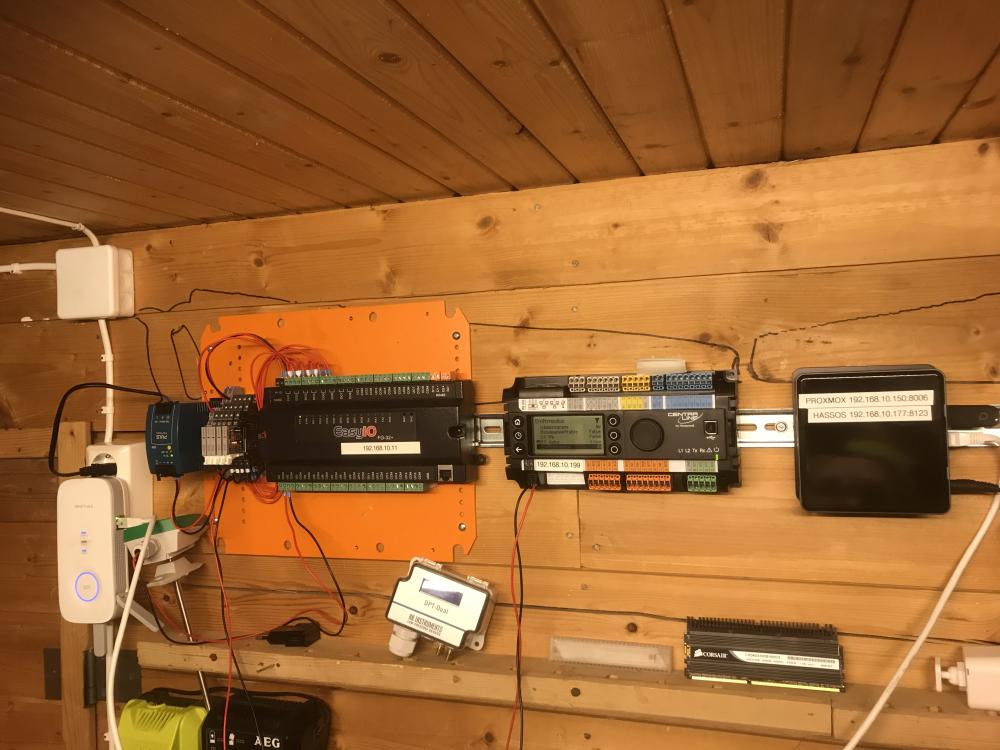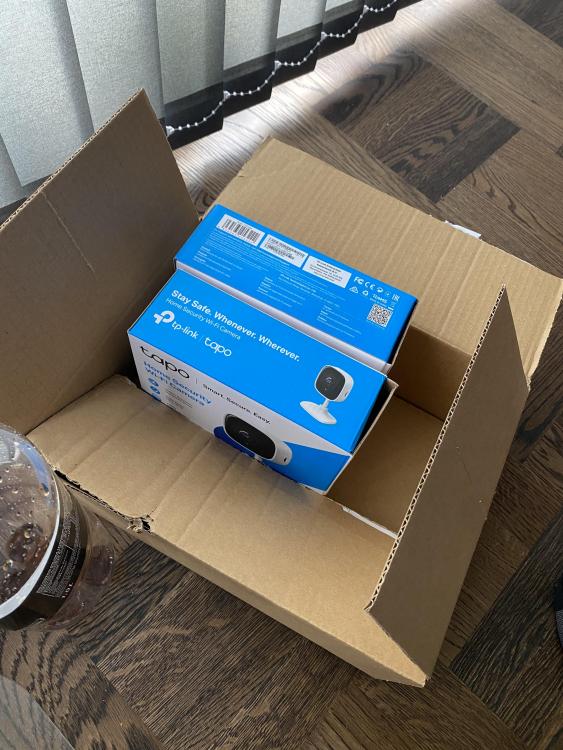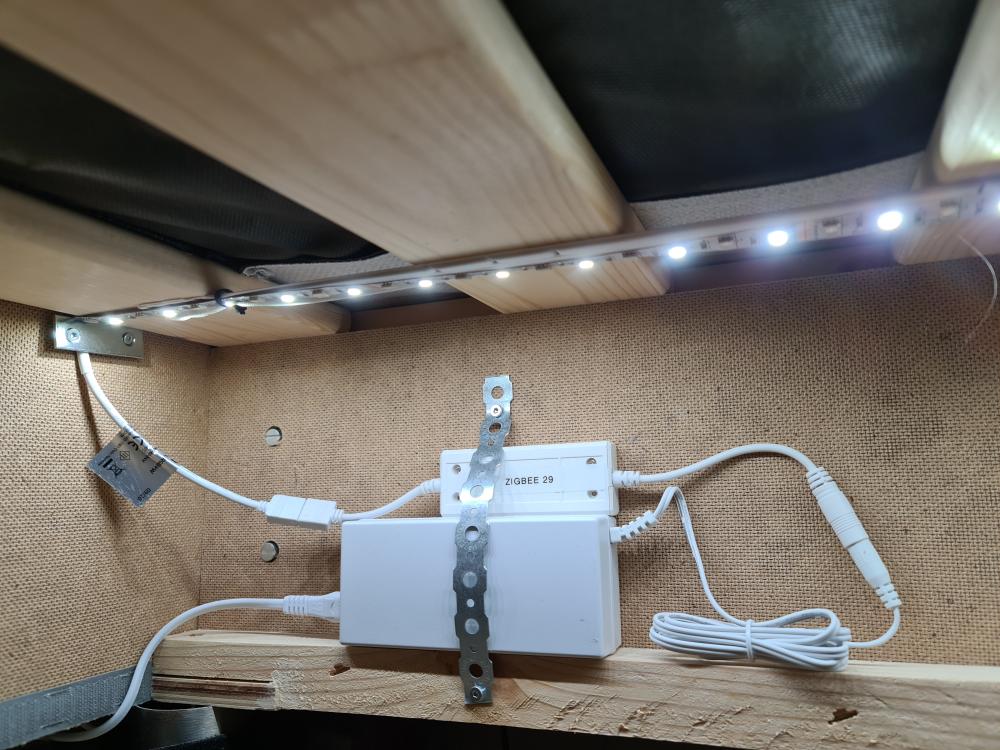Vinnerliste
Populært innhold
Viser innholdet med mest poeng fra 30. mars 2021 i alle områder
-
2 poeng
-
Har du tenkt å bruke noe OCR-greier eller skal du bare åpne camfeeden hver gang du skal sjekke hvor lang tid det er igjen?1 poeng
-
Da var jeg i mål! Fant ut av problemet, det var kombinasjonen av vanlig "basic auth" og OAuth2 som skapte problemer. Takk til @Charlie for å ha sett igjennom konfig etterpå, for å utelukke evt store "tabber"... Jeg fulgte i utgangspunktet denne guiden: https://dev.to/ahmedmusaad/add-google-authentication-to-any-website-using-nginx-and-oauth-proxy-259l (men last ned nyeste versjon, ikke 5.0.0!!!) Også viktig å merke seg at man i "oauth_proxy.service" må bruke to bindestrek foran config, når man bruker nyere versjoner av oauth2-proxy: "--config=/opt/oauth2_proxy/oauth2_proxy.cfg" "Oppskriften" for hva man måtte gjøre på Google sine sider var litt utdatert, så den delen stemmer bedre med denne guiden: https://devopsloggers.com/2020/05/30/oauth2_proxy-google-authentication-using-nginx-on-ubuntu-18-04/ Min oauth2_proxy.cfg: ## OAuth2 Proxy Config File ## https://github.com/oauth2-proxy/oauth2-proxy ## <addr>:<port> to listen on for HTTP/HTTPS clients http_address = "127.0.0.1:4180" # https_address = ":443" ## Are we running behind a reverse proxy? Will not accept headers like X-Real-Ip unless this is set. reverse_proxy = true ## TLS Settings # tls_cert_file = "" # tls_key_file = "" ## the OAuth Redirect URL. # defaults to the "https://" + requested host header + "/oauth2/callback" redirect_url = "https://mitt-domene.no/oauth2/callback" ## the http url(s) of the upstream endpoint. If multiple, routing is based on path # upstreams = [ # "http://127.0.0.1:8080/" # ] ## Logging configuration logging_filename = "/var/log/oauth2.log" logging_max_size = 100 logging_max_age = 30 logging_local_time = true #logging_compress = false standard_logging = true #standard_logging_format = "[{{.Timestamp}}] [{{.File}}] {{.Message}}" request_logging = true #request_logging_format = "{{.Client}} - {{.Username}} [{{.Timestamp}}] {{.Host}} {{.RequestMethod}} {{.Upstream}} {{.RequestURI}} {{.Protocol}} {{.UserAgent}} {{.StatusCode}} {{.ResponseSize}} {{.RequestDuration}}" auth_logging = true #auth_logging_format = "{{.Client}} - {{.Username}} [{{.Timestamp}}] [{{.Status}}] {{.Message}}" ## pass HTTP Basic Auth, X-Forwarded-User and X-Forwarded-Email information to upstream # pass_basic_auth = true # pass_user_headers = true ## pass the request Host Header to upstream ## when disabled the upstream Host is used as the Host Header # pass_host_header = true ## Email Domains to allow authentication for (this authorizes any email on this domain) ## for more granular authorization use `authenticated_emails_file` ## To authorize any email addresses use "*" email_domains = [ "mitt-domene.no" ] ## The OAuth Client ID, Secret client_id = "**********************" client_secret = "*******************" ## Pass OAuth Access token to upstream via "X-Forwarded-Access-Token" # pass_access_token = false ## Authenticated Email Addresses File (one email per line) #authenticated_emails_file = "/etc/oauth2-proxy/authorized_emails.txt" ## Htpasswd File (optional) ## Additionally authenticate against a htpasswd file. Entries must be created with "htpasswd -s" for SHA encryption ## enabling exposes a username/login signin form # htpasswd_file = "" ## Templates ## optional directory with custom sign_in.html and error.html # custom_templates_dir = "" ## skip SSL checking for HTTPS requests # ssl_insecure_skip_verify = false ## Cookie Settings ## Name - the cookie name ## Secret - the seed string for secure cookies; should be 16, 24, or 32 bytes ## for use with an AES cipher when cookie_refresh or pass_access_token ## is set ## Domain - (optional) cookie domain to force cookies to (ie: .yourcompany.com) ## Expire - (duration) expire timeframe for cookie ## Refresh - (duration) refresh the cookie when duration has elapsed after cookie was initially set. ## Should be less than cookie_expire; set to 0 to disable. ## On refresh, OAuth token is re-validated. ## (ie: 1h means tokens are refreshed on request 1hr+ after it was set) ## Secure - secure cookies are only sent by the browser of a HTTPS connection (recommended) ## HttpOnly - httponly cookies are not readable by javascript (recommended) cookie_name = "_oauth2_proxy" cookie_secret = "******************" #cookie_domains = "gmail.com" cookie_expire = "24h" cookie_refresh = "1h" cookie_secure = true #cookie_httponly = true Min nginx-konfig: ## # You should look at the following URL's in order to grasp a solid understanding # of Nginx configuration files in order to fully unleash the power of Nginx. # http://wiki.nginx.org/Pitfalls # http://wiki.nginx.org/QuickStart # http://wiki.nginx.org/Configuration # # Generally, you will want to move this file somewhere, and start with a clean # file but keep this around for reference. Or just disable in sites-enabled. # # Please see /usr/share/doc/nginx-doc/examples/ for more detailed examples. ## # These IPs will be allowed to use HTTP and won't redirect to HTTPS geo $allow_http { default 0; 10.0.1.100 1; # NodeMCU 10.0.1.123 1; # Arduino } # HTTP-server server { listen 80; server_name homeseer.local; error_log /var/log/nginx/error.log; access_log /var/log/nginx/access-80.log; #rewrites http to https, but not for allowed HTTP-clients (see geo-statement) if ($allow_http = 0) { rewrite ^ https://$server_name$request_uri? permanent; } root /usr/local/HomeSeer/html; add_header X-Whom direct; # Add index.php to the list if you are using PHP index index.html index.htm index.nginx-debian.html index.php; #Prevents hidden files (beginning with a period) from being served location ~ \/\. { access_log off; log_not_found off; deny all; } # serve HS3 json api via proxy location ~* \/(JSON|json) { proxy_http_version 1.1; proxy_set_header Connection ""; # Require login or spesific IP satisfy any; auth_basic "Krever autentisering!"; auth_basic_user_file '/etc/nginx/.htpasswd'; allow 127.0.0.1; allow 10.0.1.100; # NodeMCU deny all; proxy_set_header X-Forwarded-For $proxy_add_x_forwarded_for; proxy_pass http://127.0.0.1:8080 ; # Homeseer running on port 8080 add_header X-Whom json; expires -1; } # Mostly used to host files to show on Chromecasts # Allow access for IoT-network location ~* \/(cast) { allow 10.0.2.0/24; deny all; include /etc/nginx/fastcgi.conf; fastcgi_pass unix:/run/php/php7.0-fpm.sock; } ## All PHP-files should be handled as PHP location ~ \.php$ { try_files $uri =404; include /etc/nginx/fastcgi.conf; fastcgi_pass unix:/run/php/php7.0-fpm.sock; } } # Default server configuration # server { server_name homeseer.local; # SSL configuration # listen 443 ssl http2 default_server; # listen [::]:443 ssl default_server; # # Note: You should disable gzip for SSL traffic. # See: https://bugs.debian.org/773332 # # Read up on ssl_ciphers to ensure a secure configuration. # See: https://bugs.debian.org/765782 # # Self signed certs generated by the ssl-cert package # Don't use them in a production server! # # include snippets/snakeoil.conf; include snippets/ssl-homeseer.local.conf; include snippets/ssl-params.conf; proxy_intercept_errors on; # Don’t show the Nginx version number (in error pages / headers) server_tokens off; access_log /var/log/nginx/access-443.log; error_log /var/log/nginx/error.log; error_page 404 /error/HTTP404.html; error_page 403 /error/HTTP403.html; error_page 502 /error/HTTP502.html; # error_page 401 /error/HTTP401.html; root /usr/local/HomeSeer/html; add_header X-Whom direct; # Add index.php to the list if you are using PHP index index.html index.htm index.nginx-debian.html index.php; #Prevents hidden files (beginning with a period) from being served location ~ \/\. { access_log off; log_not_found off; deny all; } # Everyone needs access to /oauth2 to be able to authenticate location ^~ /oauth2 { proxy_pass http://127.0.0.1:4180; proxy_set_header Host $host; proxy_set_header X-Real-IP $remote_addr; proxy_set_header X-Scheme $scheme; } # serve HS3 json api via proxy location ~* \/(JSON|json) { proxy_http_version 1.1; proxy_set_header Connection ""; satisfy any; auth_basic "Krever autentisering!"; auth_basic_user_file '/etc/nginx/.htpasswd'; allow 127.0.0.1; deny all; proxy_set_header X-Forwarded-For $proxy_add_x_forwarded_for; proxy_pass http://127.0.0.1:8080 ; # Homeseer running on port 8080 add_header X-Whom json; expires -1; } location ~ \.php$ { auth_request /oauth2/auth; error_page 401 = /oauth2/sign_in; proxy_set_header Host $host; proxy_set_header X-Real-IP $remote_addr; proxy_set_header X-Forwarded-For $proxy_add_x_forwarded_for; proxy_pass_header Server; # if you enabled --cookie-refresh, this is needed for it to work with auth_request auth_request_set $auth_cookie $upstream_http_set_cookie; add_header Set-Cookie $auth_cookie; try_files $uri =404; include /etc/nginx/fastcgi.conf; fastcgi_pass unix:/run/php/php7.0-fpm.sock; } # deny access to .htaccess files, if Apache's document root # concurs with nginx's one # location ~ /\.ht { deny all; } # Default matches everything and requires authentication location ~* / { auth_request /oauth2/auth; error_page 401 = /oauth2/sign_in; proxy_set_header Host $host; proxy_set_header X-Real-IP $remote_addr; proxy_set_header X-Forwarded-For $proxy_add_x_forwarded_for; proxy_pass_header Server; # if you enabled --cookie-refresh, this is needed for it to work with auth_request auth_request_set $auth_cookie $upstream_http_set_cookie; add_header Set-Cookie $auth_cookie; proxy_set_header X-Forwarded-For $proxy_add_x_forwarded_for; proxy_pass http://127.0.0.1:8080 ; # Homeseer running on port 8080 add_header X-Whom HS3; expires -1; } location ^~ /error/ { internal; alias /usr/local/HomeSeer/html-error/; auth_basic "off"; allow all; } } Hvis oauth-servicen stopper så gir nginx en 500-server-error, så det er ikke slik at all autentisering bypasses om den krasjer. Jeg kjører selvsagt Monit til å sjekke at den kjører og restarter den hvis ikke...1 poeng
-
1 poeng
-
Trykksensorene "mine" fungerer fint enda.1 poeng
-
1 poeng
-
Har brukt nginx som reverseproxy i produksjon på jobb og hjemme noen år. Send meg conf så kan jeg se om jeg ser noe feil.1 poeng
-
Ja, jeg har tenkt tanken. Har lurt på å skrive et par "komme i gang med scripting" poster, så det blir nok en del av det.1 poeng
Vinnerlisten er satt til Oslo/GMT+01:00








